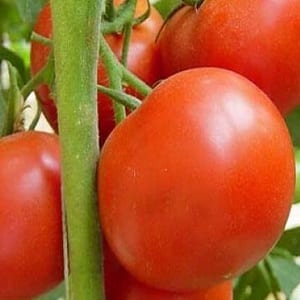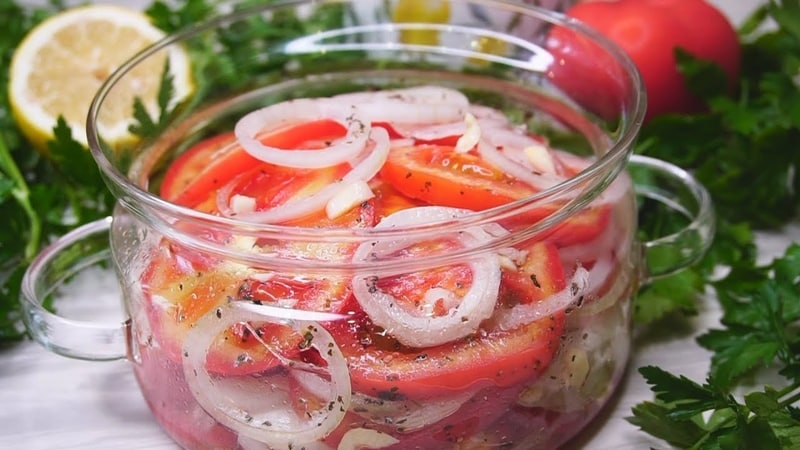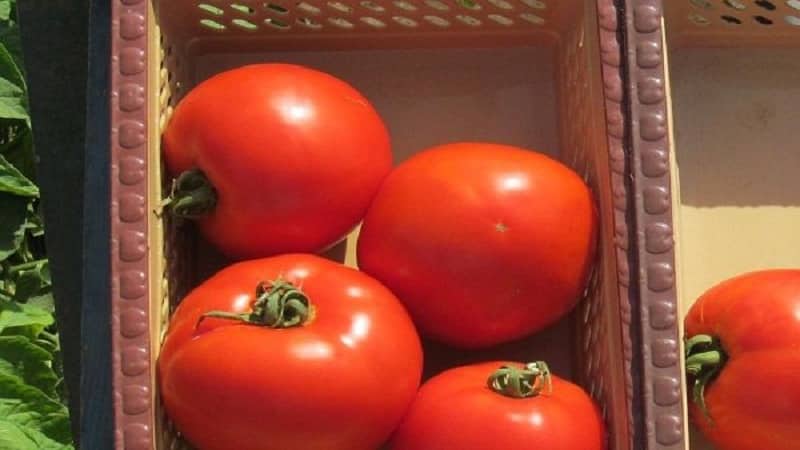A productive hybrid with excellent taste - the Florida tomato and its advantages
Florida f1 is a Dutch hybrid for cultivation in open ground in the southern regions and in greenhouse conditions in the northern regions. The culture is characterized by uniform yield of fruits and resistance to temperature fluctuations.
In this article we will talk about the advantages and disadvantages of the hybrid, the nuances of agricultural technology and the differences from the Florida Petit variety.
Description of the hybrid
An early maturing hybrid of the Dutch selection of the Monsanto company. It was included in the State Register of Russia in 2007. The crop is suitable for cultivation in closed and open soil. Bushes determinant, do not require pinching and garters. The rhizome is powerful - it goes 2.5 m deep into the ground.
In the photo - hybrid Florida 47 f1.

Distinctive features
The table provides a description of the Florida hybrid.
| Indicators | Characteristic |
| Weight | 180-250 g |
| Form | Flat-round, smooth |
| Coloring | Red |
| Leaves | Medium size, green |
| Type of inflorescences | Intermediate |
| peduncle | With articulation |
| Number of slots | Four to six |
| Pulp | Medium density, juicy |
| Taste | Sweet, pleasant |
| Skin | Dense, does not crack |
| Purpose | Salad hybrid |
| Bush height | 60-70 cm |
| Ripening period | 110-115 days after germination |
| Productivity | 5-6 kg/m² |
| Sustainability | To verticillium, fusarium wilt |
| Transportability | High |
How to grow seedlings
Sowing seeds for seedlings is carried out from March to May.Such a long sowing period is due to the fact that the hybrid is intended for summer-autumn rotation. Fruiting continues until the onset of frost.
Preparing soil and seeds
The seeds of the Florida 47 hybrid do not need to be soaked in a disinfectant solution or germination stimulants.. The material undergoes careful processing in production before packaging into bags.
The soil for sowing is mixed from equal parts of chernozem, humus, and peat. For every 10 kg add 20 g of superphosphate and wood ash. Gardening stores sell ready-made substrates in bags for growing tomatoes with the necessary set of nutritional components. Both types of soil are first disinfected with a solution of potassium permanganate or calcined in the oven.
To cultivate the soil from the garden use:
- fungicide "Fitosporin" (15 ml per 10 l);
- insecticides: “Aktara”, “Inta-Vir”, “Grom”, according to the instructions a month before sowing.
Sowing
Growing containers seedlings fill with moist soil and sow seeds in furrows 1.5 cm deep at a distance of 2 cm. 1 cm of soil is poured on top. The containers are covered with plastic wrap or glass and placed in a dark place.
The optimal temperature for germination is +22…+25 °C. The film is periodically removed for half an hour to avoid soil molding.
Seedling care
After the sprouts appear, the containers are placed on the windowsill on the sunny side. Seedlings need sufficient light for normal development. It is recommended to extend daylight hours to 16 hours with the help of phytolamps.
Picking into separate glasses is done after the appearance of true leaves. The roots are shortened by 1/3 to stimulate the development of strong rhizomes.
Watering the seedlings is moderate, at the root level, as the top layer of soil dries.
1-2 weeks before being transferred to the ground, the seedlings are taken out to the balcony to harden and strengthen their defenses.
Agricultural technology of tomatoes
Cultivation of the Florida 47 hybrid involves moderate moisture, loosening the soil or mulching with agrofibre, installing a drip irrigation system, and applying organic and mineral fertilizers.
Landing
The place for planting seedlings is chosen to be sunny, without drafts. Planting of seedlings in the ground begins after reaching 10 cm in height, 35-40 days after sowing. The ideal time for transferring to open ground is the second or third ten days of May, when the threat of frost has disappeared. Seedlings are planted in greenhouses when the ground warms up to +16 °C.
The distance between bushes should not exceed 60 cm.
Watering and loosening
Florida tomatoes like moderate watering, do not tolerate waterlogging and stagnation of water in the soil. The optimal level of humidity in the area will be provided by a drip irrigation system.
The soil is covered with black agrofibre to prevent the formation of a hard crust and the growth of weeds. The non-woven mulch covering perfectly allows moisture and air to pass through.
Advice. Instead of agrofibre, you can use straw, peat and sawdust.
There is no need for pinching bushes. The shoots do not interfere with the formation of ovaries and the ripening of fruits. Low-growing bushes do not require tying to supports.

Top dressing
Hybrid Florida needs organic and mineral fertilizers. Alternating several types of fertilizing increases productivity. The root system and the ground part of the bush completely assimilates organic matter, which stimulates the development of the plant and strengthens its defenses.
Stages of fertilizing:
- after transferring the seedlings to a permanent place - organic matter;
- before the formation of flower clusters and during the formation of ovaries - potassium-phosphorus fertilizers;
- during the fruiting process - potassium fertilizing with a small amount of phosphorus and nitrogen.
The interval between procedures is 10 days to avoid oversaturation of plants. The last portion of fertilizer is applied 14 days before the start of tomato harvesting.
Organic fertilizer options:
- Take one part mullein to 5 parts water. Leave for two weeks, then dilute with water 1:2. Used for watering bushes at the root after planting seedlings in the ground, during flowering and fruiting.
- The bucket is filled 2/3 full with chopped nettles and water is poured to the top.. Leave for 14 days and dilute with water for irrigation 1:10, for spraying - 1:20.
- For 10 liters of water take 2 cups of wood ash, leave for three days, filter and use for watering at the root.
Options for mineral supplements:
- 40 g of potassium sulfate per 10 liters of water. This amount of solution is enough to treat 1 m².
- 20 g of superphosphate per 1 liter of boiling water. The mixture is infused for 24 hours, then the volume is adjusted to 10 liters.
- 10 g diammofoski (26% potassium and phosphorus, 10% nitrogen) per 10 liters of water. The solution is used to water 1 m² of soil.
- 1 tbsp. l. nitroammofoski (16% potassium, phosphorus and nitrogen each) per 10 liters of water. Consumption per bush – 500 ml.
Features of cultivation
Florida hybrid is picky about soil composition. It shows the best results when grown in moderately acidic soil with a pH level of 6-6.5, dense and rich in oxygen. To determine the acidity of the soil, litmus papers or special devices with a long probe are used, which can be purchased at gardening stores.
The best crop predecessors are cabbage, onions, and carrots.
Important! Tomatoes need sunlight and moderate humidity.
Diseases and insects
Hybrid Florida f1 is resistant to verticillium wilt, fusarium wilt, alternaria blight, gray spot, and tobacco mosaic. But like any other mid-season crops, tomatoes are susceptible to late blight infection.
Signs of the disease:
- gray-brown spots on leaves, stems and tomatoes;
- whitish coating on the back of the leaves;
- fruit deformation.
For prevention, greenhouses are fumigated with sulfur bombs, the soil is disinfected with copper sulfate, the soil is covered with mulch (sawdust, peat, pine needles, hay, agrofibre), and moderate watering is provided.
If the infection could not be prevented, the following drugs will come to the rescue: “Quadris”, “Fitosporin-M”, “Baikal”, “Antrakol”. Manufacturers indicate instructions for use and dosage on the packaging. Treatment frequency is once every two weeks.
Get rid of pests (aphids, whiteflies, spider mite) insecticides will help: “Fitoverm”, “Neoron”, “Aktellik”.
Folk remedies are no less effective:
- 200 g of garlic arrows per 1 liter of warm water. Leave for seven days in a dark place. Add 50 ml of concentrate to 10 liters of water.
- Pour 100 g of onion peel into 1 liter of water. Leave for 12 hours, use for spraying bushes.
- Pour 100 g of dry yarrow herb into 1 liter of warm water. Leave for three days, strain and spray the bushes.
These products are used once a week.
The nuances of growing in open ground and in a greenhouse
Gardeners often practice the method of planting the Florida hybrid in a greenhouse and in the garden - on the spread.To do this, long trenches 10 cm deep are dug, the seedlings are laid lying down in such a way that only the top with flowers and leaves remains on the surface.
The lower leaves, 4-5 pieces, are torn off and the stem is covered with earth. This ensures the development of a powerful root system that will feed the ground part.
Harvesting and application
Fruit harvesting begins 110-115 days after germination.
Tomatoes are universally used; they are used for preparing fresh seasonal salads, vegetable slices, juice, sauces, pasta, adjika, stew, winter conservation.

Advantages and disadvantages
Advantages of a hybrid:
- powerful root system;
- there is no need to carry out pinching and gartering of bushes;
- excellent taste;
- wide foliage protects tomatoes from the scorching sun when grown in open ground;
- flower clusters are formed through the leaf and produce fruit ovaries throughout the entire period of plant growth;
- the culture is resistant to sudden weather changes;
- has immunity to nightshade viral diseases;
- the hybrid is endowed with a keeping quality gene - tomatoes are stored without loss of presentation for 2-3 months;
- tolerates transportation well.
Flaws:
- the plant is demanding on the composition of the soil;
- does not tolerate excess moisture.
Not to be confused with Florida Petit variety
In addition to the hybrid Florida f1, a tomato with the similar name Florida petite is cultivated. This is a variety of miniature cherry tomatoes that can even be grown on a windowsill or balcony.
The plant is suitable for cultivation in open and closed ground, and has the following characteristics:
- ultra early ripening - 95 days from the appearance of sprouts;
- low-growing bushes do not exceed 30 cm in height;
- friendly ripening of small fruits;
- About 500 g of tomatoes are collected from one bush;
- ease of care;
- disease resistance;
- long shelf life;
- possibility of transportation over long distances;
- maximum fruit weight – 20 g;
- color when ripe is red;
- the pulp is sweet, aromatic;
- The fruits are suitable for canning, drying and fresh consumption.
In the photo - the Florida Petit variety.

Read the information on the seed package carefully to choose the crop you need.
Reviews
Gardeners leave positive reviews about Florida and Florida petit tomatoes.
Inga, Vyksa: “Florida Petit learned about the variety of small tomatoes quite recently. I saw whole bunches of red fruits on my friend’s balcony and was inspired to grow them in a greenhouse at the dacha. I was pleased with the result. The yield was higher than stated on the package, and there was no need to put in much effort in care.”
Ivan, Obninsk: “I have been growing a Florida hybrid in a greenhouse for two years in a row. Tomatoes grow large, have a pleasant taste, and are stored for a long time. The crop rarely suffers from late blight, so I try to do preventive measures for this – I ventilate the greenhouse, water it moderately, and mulch the soil with sawdust.”
Evgenia, Yeysk: “Florida f1, in my opinion, is one of the best low-growing hybrids. I grow tomatoes in the garden using the spreading method. Fruiting is abundant and long lasting. Tomatoes ripen together, have the same size, uniform color, dense but tough skin. They need moderate watering and fertilizing.”
Conclusion
Florida 47 f1 tomatoes are deservedly popular among professional farmers and amateur gardeners due to their high productivity, excellent taste, long shelf life (2-3 months) and the possibility of transportation.
The culture is not susceptible to infection by viruses, and is rarely affected by late blight, provided that preventive measures are followed.